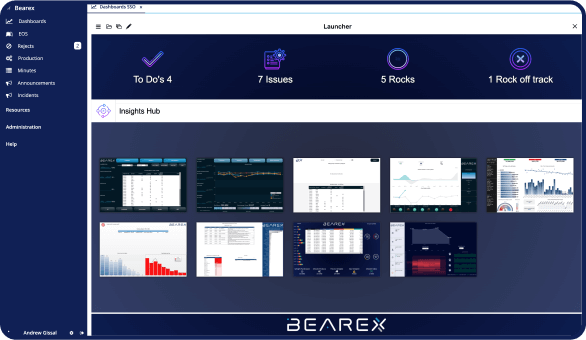
Published February 03, 2022, By Andrew Gissal


Ask yourself:
How do you evaluate progress and productivity? Assess skills? Overarching, how do you measure success? All of these are ambiguous terms but each of value when it comes to reviewing what we know as performance. Now throw in the fact the variable being measured is not the performance of something but rather the performance of someone. This makes things even more ambiguous and subject to challenges, right?
That’s just it – performance reviews can often be seen as challenging to any kind of professional across any business. So what does it come down to?
As business professionals, we are expected to measure qualitative information about those we work with when we ourselves, are qualitative beings. We run on intangible and other qualitative thoughts that drive the behaviors and skill-sets we are being measured on in our roles. While there are role-specific quantitative measures of performance, it is these ambiguous and inexact components that are still necessary and universal to performance reviews across the board.
Effectively evaluating someone in their performance across all these areas in a quantitative way is easier said than done. Without a standardized method or process, it can be difficult to know where to begin or have any rule of thumb as it pertains to a comparative scale for which to base your assessment off of. Even if it’s a qualitative portion of the annual review your entire team has consistently been doing, it becomes a bit more convoluted for one to accurately and surely denote a true change has occurred (whether progression or area for improvement) when there is no numerical evidence. While empirical evidence exists, this can be a cause for disorganization and inconsistencies, maybe not always at the year-over-year individual level, but at the cross-sectional level of how one manager evaluates their direct reports over another manager.
So what does this mean? Where do you go from here? Our 3-part answer is simple, and the process to get there doesn’t have to be complicated either:
In this blog, we want to provide additional insight for Human Resources departments on various ways to implement data into performance reviews, and how it can easily become a process deployed across the entire organization. Let’s break down those 3 ways you can get started today:
For anyone conducting a performance review, it’s likely you are already taking a step back to gain a full understanding of all that you’re evaluating. Even if simply done via observations and quick notes, this intake is allowing you to gain a full picture into the behavior patterns and skill sets that your colleagues are displaying over the course of time, not just in the present moment.
While more informal, there is something to take away from this process.
It mirrors exactly what organizations can and should allow the data available to them to produce – a full intake and wide lens gauge of their information. Take a step further, and organizations can use that data and information to drive a more thorough performance review-business wide. The key to ensuring this succeeds? Access.
You don’t know what you don’t know. And when it comes to data, you may think you have the full picture when in fact you really are just looking through a smaller lens; so it appears nothing is missing, but much more lies outside the existing boundaries that would help provide context.
That’s where data extraction becomes pivotal. At Bearex, we refer to the start of this process as ‘taking inventory’ – looking at the expansive network that is your most utilized reports, tools, databases, and meetings – to better understand the workflows in place and where gaps may result. In doing so, every necessary piece of data can be pulled from its source and become an interconnected web with one another for automated entry, analysis, and further action.

Here are elements to consider in your inventory as it relates to extracting data that will improve performance reviews:
Self-evaluations
Checklists
Participation and engagement surveys
Not only is analyzing existing data a helpful way to get more out of your performance reviews, but so is the method in which you conduct the appraisal itself.
It’s likely we have all heard of KPIs before – Key Performance Indicators.
And that’s exactly what they are. Key. Indicators. Of Performance. They don’t just have to be utilized when measuring operational efficiency or YOY budget, they can also effectively be applied for those who make the business run smoothly – the employees. As Performance Measure Specialist, Stacey Barr states, “Qualitative variables aren’t performance measures. But they are used to help us analyze our measures.”
Whether you have a more qualitative and standardized method for performance reviews in place (e.g. graphic rating scales, checklists, goal tracking, etc.), or instead a more fluid and conversational approach (e.g. self-evaluations, competency assessment, etc.) it is critical to assess how effective that method currently is, or could be, at achieving the end goal of a balanced review that promotes further development. What works at one business may not work at the next, so be wise when comparing across those in your segment or industry, and remember that consistency across others in the business and consistency across time remains necessary. This ensures objectivity and accountability for everyone involved.
The best way to ensure your method is objective and becomes standard for all teams, whether more quantitative or qualitative, is to ensure all information is accessible.

To evaluate two colleagues without the same information available is to compare apples to oranges. And to translate one review as a determining insight for the rest of the team is to say you’ve only ever tried Gala apples.
No two people are alike, this will never change. That’s why accessibility, consistency, and integrity are so important to making a performance review, or any use of data for actionable insight, complete and valid. However, that comes with its own unique challenges – expenses for in-house development, resources used towards cumbersome maintenance, and lack of streamlined knowledge transfer over time.
Imagine if everything could be covered financially and logistically, from data ideation to ongoing analysis – what opportunities would exist for the development and growth of not only your employees, but your organization as a whole?
When you provide one place for all systems to merge, you’re left with a fully accessible platform to lean into whenever and wherever you need it – for instant reporting, visible dashboards, detailed analytics, or seamless data entry.
Your people matter, your decisions matter, and every person is capable of making a decision that matters. We’re excited to show you how.

As COO & EOS Implementer at Bearex, Andrew aims to help entrepreneurial businesses use data to gain traction through his experience in organizational leadership and startup sales & marketing.

Andrew Gissal